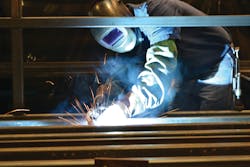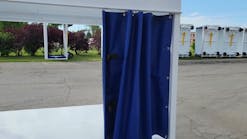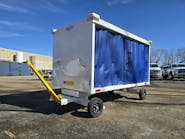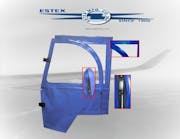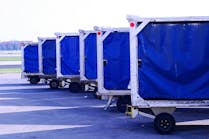The Three Keys To Getting the Best ROI On Your Next Dolly Fleet
Wheels. Steel. Towbars. Dolly designs may seem relatively simple, but there’s a lot more to the equipment — from where the rubber hits the tarmac to the many sizes and styles of platforms.
There are the basics, certainly — container sizes, various cargo capacities and facility workspaces. And then there are the highly individualized requirements and specifications for different companies. For this very reason, tarmacs globally are crowded with hundreds of distinct models of dollies.
To get the best return on investment while maintaining the safest worksite possible, buyers for an airline, air cargo business or other company need to be prepared. You should have a clear understanding of what takes a dolly beyond the basics and focus on the details — from vertical restraints to locks to towbars — to determine what will make your operation most efficient and what’s simply overkill.
Start by evaluating key areas of daily operations, from worksite to usage. Those aspects will come into play when deciding between orientation, weight capacity, load sizes and key dolly features that could trim the fat and make the tarmac safer ground.
When focusing on dolly details, buyers also should aim to purchase products that will result in the highest ROI, paying special attention to three key elements: versatility, durability and safety.
VERSATILITY
Dolly capacities are all over the board. Each style can haul certain containers or combinations of containers. For example, some can only handle a single LD-2 container, while others can haul multiple containers or pallets at a time. These dollies contain LD stops and vertical restraints throughout to firmly lock different sizes of containers in place.
The first step is to determine what sizes of containers or cargo pallets are typical, as well as the weight ranges. Then, look into what works best. Do you need vertical restraints? Do you haul a mix of pallets and containers? Do you work in an area better suited to side-tow or front-tow designs?
Some companies might need several types of dollies to accommodate different needs. A more economical approach is to select a versatile dolly that allows you to replace multiple dollies with various capacities with a single piece of equipment that can manage numerous styles of containers and pallets. The multifaceted dolly will be easier to use and will help boost worker efficiency, especially for airlines or cargo companies that require switching between cargo and containers.
Other dolly components further impact the unit’s versatility. For example, each dolly incorporates either rollers or casters, and the choice between the two comes down to operational needs. For instance, if a company can only perform side load transfers, rollers might be best because it’s easier to move heavy loads over rollers. Further, since the rollers are larger and more durable, they are less likely than casters to be damaged by those loads. Relatively speaking, roller beds generally require less maintenance, as well. But one drawback of rollers is the limitation of movement. Once a container is on the dolly, it is limited to simply forward and backward motion.
From an operational standpoint, it’s usually easier for employees to work with caster beds. Casters are multidirectional, so operators can rotate the container in any direction once it is loaded. This flexibility allows for easier and faster loading and unloading.
Further, some manufacturers offer inverted casters. These are more resilient and less likely to break or become damaged under the constant movement of heavy loads. With caster protection, only about a half inch of the caster extends beyond the plane of the dolly’s frame, rather than the entire caster being exposed. When exposure is minimized, these parts are apt to last longer and require fewer repairs and less maintenance.
Aside from realizing greater efficiency with a more versatile dolly, purchasing departments should place significant weight on the dolly’s construction and durability, and in more ways than one.
DURABILITY
Keeping only the highest quality equipment on the tarmac is the best way to reduce liability, prevent aircraft strikes and eliminate havoc. The same holds true for long-term ROI; pinching pennies might not be the best approach to finding that lasting product that will lower costs over the long haul. Rather, evaluate the features each unit offers that will increase long-term ROI. As you do so, keep in mind that a well-built unit is one that is strategically engineered, put through rigorous testing and doesn’t have any breakaway parts.
Start with the parts and components. Examine casters and rollers to determine whether the quality can withstand frequent loading, heavy loads and changing loads. Check out the rims and tires. Customers looking for the longest-lasting option, rather than just the one with the lowest initial cost, should request solid rubber tires. With no valve stems or tubes, the worry of getting a flat is completely eliminated. Conveniently, they also are less expensive, even though they are more durable than pneumatic tires.
Pay special attention to the towbar, as well, ensuring it is integrated into the frame and manufactured with heavy-duty materials. As with any piece that comes into contact with other equipment, the towbar should be strongly engineered with durable materials to prevent potential incidents. Further, ask questions about the towbar operation. The best manufacturers use dual springs to prevent the towbar from hitting the ground when it is dropped. This not only prevents injury, but also extends the life of the towbar.
Check out the hardware, too. What grade is it? Grade 2 hardware, although common in the industry, will not stand the test of time, and frankly, should be unacceptable in this safety-focused industry. Look for equipment with a solid, heavy-duty steel frame with Grade 5 zinc hardware throughout to prevent failures in the field. As a point of reference, compare Grade 2 to Grade 5. Grade 2 is formed with low or medium carbon steel and has a minimum tensile strength of 74,000 pounds per square inch. Grade 5 hardware is formed of medium carbon steel and features a minimum tensile strength of 120,000 psi — 46,000 psi more than Grade 2.
Zinc-plated components also will help prevent corrosion that’s inevitable with lower-quality metals when they are exposed to the elements 24/7. In addition to zinc-plated hardware, many companies prefer powder-coated equipment as an additional line of defense against equipment fading, scratching and chipping. Powder coating not only makes equipment look better longer, but it’s corrosion resistance also helps equipment last longer. Some manufacturers offer hot-dip galvanizing to further protect a dolly from corrosion.
Next, consider how the piece of equipment is manufactured. Is the production of dollies a small portion of a varied business, or does the company specialize in manufacturing ground support equipment? A manufacturer with a ground support equipment focus will understand the unique rigors, safety requirements, and liability issues that come with equipment operating on busy tarmacs where collisions with expensive equipment are just one of many possible concerns.
Additionally, ensure the dolly manufacturer employs American Welding Society certified welders, who have the additional training and skills needed to guarantee better welds and durable construction.
Ask questions about the company’s testing processes. Some manufacturers hook up strain gauges and test equipment on washboard tracks to ensure product designs are durable, long lasting and reliable. Some also have dedicated quality inspection personnel following carefully laid-out ISO procedures. ISO (International Organization for Standardization) certification ensures that nothing but the customer received only the highest quality equipment.
Check out a company’s reputation, too. Word-of-mouth reviews and industry longevity provide key indicators of the type of product you’ll get. Find a manufacturer with decades of experience. Better yet, find one whose early equipment is still in use daily. There’s no better way to know if what you buy today will hold up.
Further, select a company that has optimized the industrial design of its equipment so it can be built with more stock steel sizes and components. These companies usually can manufacture faster and hold units in inventory for quick order fulfillment. Ask about their manufacturing processes, as well. Does the company use the best equipment, such as robotic welding machines and large-scale laser and plasma cutters, for consistent quality in everything it produces?
Beyond this, consider if the company’s design alleviates shipping time and expenses for you. Some dollies are designed for ease of shipping and inexpensive transport. For example, stackable dollies, which can be stacked as many as five high and rolled onto a transport vehicle without crating, allow for fast, inexpensive shipping. And remember that any kind of crate-free shipping is a benefit, as cargo containers are expensive to rent. Roll-on and roll-off capabilities allow transport without those crates, plus it makes loading and unloading easy.
Finally, never elect to work with a company that isn’t ISO-certified. This certification validates a company’s processes to ensure they meet the most stringent quality standards. Along with these certifications and standards, manufacturers should be well versed in CE, SAE and OSHA guidelines, as well. Perhaps most importantly, the company needs to be willing and able to accommodate your company’s safety department’s unique requirements.
SAFETY
Most companies have stringent safety rules and guidelines that go above and beyond what’s mandated. They know they’re liable, and more importantly they care about their employees, so they adopt specific requirements to protect employees and others, as well as their reputations. These safety guidelines change from company to company; one size almost never fits all.
For example, some companies require manually engaged locking mechanisms on vertical restraints so that operators have a reminder of a task they need to perform. Others prefer spring-activated locking mechanisms to avoid an operator needing to remember to engage the mechanism.
It’s common also now for airlines to require extensive equipment manuals including operating manuals, training manuals, and train the trainer documentation, in specialized formats. This is exactly why it’s so important to find a manufacturer that offers customization and is able to quickly deliver on special requests.
Despite the wide range of specialized dollies in the market today, one thing holds steadfast, strong and true — selecting a dolly with versatility, durability and safety, all custom tailored to your requirements, will pay for itself in many ways for years to come.
About the Author: John Hoeper is the vice president of engineering for WASP Inc. He has more than 27 years of experience in GSE design and manufacturing.
